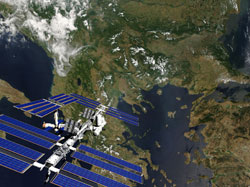Remote sensing products for environmental research
The Fraction of Absorbed Photosynthetically Active Radiation (FAPAR) is a very important environmental indicator, denoted by its status as a Global Climate Observing System (GCOS) variable. It is measured by special instrumentation aboard satellites and provides insight into the amount and productivity of surface vegetation within a given area. One of the objectives of the CAMELS project was to exploit FAPAR data to estimate carbon dioxide sequestration by the biosphere. The Joint Research Centre (JRC) of the European Commission, a CAMELS participant, contributed to this task by constructing an extensive database of FAPAR data for Europe. Data is available from 1998 through to 2004 at various projections. The data is stored in the common Hierarchical Data Format (HDF) and boasts a high spatial resolution. Database users can construct maps of FAPAR for different regions and periods of time. In addition, they can also access FAPAR by-products provided in 10-day and monthly composites for the 20+ CAMELS sites across Europe and the United States. JRC and its CAMELS partners have already begun utilising the comprehensive dataset. For instance, JRC investigated the effects of a severe drought in Europe in 2003 on vegetation and published their findings in an international journal. More information about the CAMELS project as well as the publicly available FAPAR data, documentation and additional data products are available at: http://fapar.jrc.it/WWW/Data/Pages/FAPAR_Projects/FAPAR_Projects_CAMELS_Download.php

